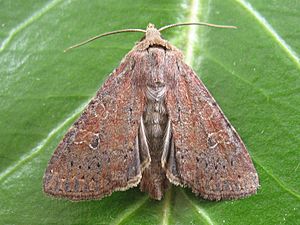Suspected facts for kids
Quick facts for kids Suspected |
|
|---|---|
 |
|
| Scientific classification | |
| Kingdom: | |
| Phylum: | |
| Subphylum: | |
| Class: | |
| Order: | |
| Family: | |
| Genus: |
Parastichtis
|
| Species: |
P. suspecta
|
| Binomial name | |
| Parastichtis suspecta (Hübner, 1817)
|
|
| Synonyms | |
|
|
The Parastichtis suspecta, also known as the suspected moth, is a type of moth. It belongs to the Noctuidae family, which includes many different kinds of moths. You can find this moth in many parts of the world. It lives across most of Europe, through Russia, and all the way east to Japan in Asia. It also lives in North America.
Contents
What the Suspected Moth Looks Like
The suspected moth is a medium-sized moth. Its wingspan is usually about 29 to 34 millimeters. That's about the length of a few small paperclips lined up!
These moths can look quite different from each other. Some might be a plain light gray color. Others can have shades of red-brown or brownish colors. They often have faint lines and patterns on their wings. This variety helps them blend into their surroundings.
Life Cycle of the Suspected Moth
Adult suspected moths are usually seen flying for a short time. They are active from late July to August in Europe. They have one generation each year.
Larvae and What They Eat
The young moths are called larvae, or caterpillars. They are purplish-brown in color. They have a yellowish-white line down their back. Their bodies also have small bumps called tubercles.
These caterpillars like to eat the leaves of certain plants. They especially enjoy Salix lapponum, Salix caprea, and Salix phylicifolia. These are all types of willow plants.
When they are very young, the larvae live inside spun shoots of their host plant. As they grow bigger, they move to spun leaves. You can find these caterpillars from April to June.
Pupation and Winter
After the larvae have grown enough, they change into a pupa. This stage happens underground. The pupa is a resting stage where the caterpillar transforms into an adult moth.
The suspected moth spends the winter as an egg. The eggs are laid on the host plant. They hatch in the spring when the weather gets warmer.

